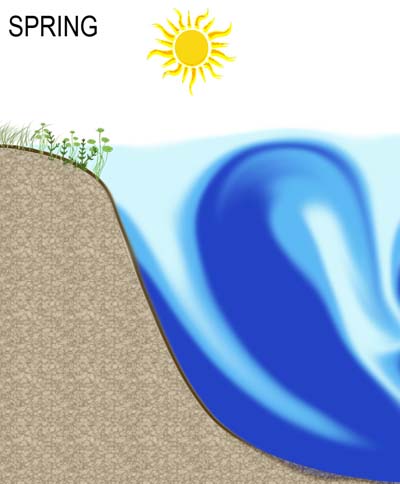

When any of these events occur and bring the carbon dioxide rich bottom lake layer to the top of the lake you have what is know as lake turnover. This gaseous layer continues to build until it is displaced, perhaps by vulcanism, seismic activity or landslides.

Pressure from the upper layers of water keeps the gases from escaping to the surface similar to how the cap on a bottle of soda water keeps the gases from escaping. It is predictable in that it happens every year, although the exact timing varies with lake. As currently understood, carbon dioxide rich springs seep into the lake bottom and over time a thick layer of this carbon dioxide builds up in the lower portion of the lake. That mixing, known as lake turnover, or simply turnover, is a fairly predictable event. These eruptions have been identified as the cause of mass death events in villages at Lake Nyos in Cameroon, Africa when these areas were overcome with the heavier-than-air carbon dioxide resulting in the suffocation of those close to the ground or unable to flee. Limnic eruption occurs when a layer of carbon dioxide rich water at the bottom of a deep body of water is displaced or disturbed and rises rapidly and erupts from the surface releasing the gas into the atmosphere. The second, known as lake overturn is also known as limnic eruption and, by all accounts, is much more rare and can be deadly. It is the unique properties of the water molecule which causes water to contract down to 40 degrees F and then to begin expanding at 39 degrees F to 32 degrees F that makes this process possible without freezing the lake through. These layers prevent the lake from mixing and aerating. For many lakes deeper than about 20 feet, distinct, thermally stratified layers of water form during the summer. As this heavy dense layer sinks it displaces the water at the lake bottom forcing the lower layers to the surface. What is lake turnover Simply put, lake turnover is the seasonal mixing of the entire water column. Seiches, sometimes nicknamed sloshes, rhythmically move back and forth across a lake. Freshwater estuaries are not affected by tides, but large bodies of water do experience predictable standing waves called seiches. Eventually they become cold enough and heavy enough to the point they begin to sink. The mixing of the two freshwater systems contributes to lake turnover the mixing of the waters of a lake. As these upper layers cool they become denser and heavier. As air temperatures drop so does the water temperature of the upper layers of a body of water. The first, known as lake turnover occurs on many large and/or deep bodies of water. In both the fall and the spring, turnover affects three major aspects of the lake environment: oxygen, algae, and phosphorus.There actually exists a process known as Lake Turnoverand an event known as Lake Overturn (Limnic Eruption). The lake “rolls over” in this way in an ongoing cycle until it freezes over. Once it reaches the other shore it gets pushed downward to replace the hypolimnion that moved up to the other side of the lake. What is lake turnover Lake turnover is the mixing of lake water when air temperature and winds cool water at the surface causing it to become denser. The wind pushes the surface water from one shore to the other, and as this happens, the hypolimnion moves upward to replace the water that is moving across to the other shore. However, the water column is isolated from wind-induced turbulence by its cap of ice. In this case the stratification is much less stable, because the density difference between 0☌ and 4☌ water is quite small. As winter approaches, a constant breeze begins to move over the surface of the lake. Most of the water column is isothermal at a temperature of 4☌, which is denser than the colder, lighter water just below the ice. This process is most noticeable in the fall. Turnover is much like a dog learning to roll over: As he pushes himself to one side, his underbelly begins to show. The two layers could not intermingle without the wind!

The epilimnion then cools to a temperature that balances with the density of the hypolimnion, allowing them to “intermingle.” The opposite occurs in the spring: the air temperature rises, warming the surface water while the bottom grows cooler. Its fall and I get asked all the time if the lakes up here in northern Wisconsin have turned over yet. In the fall, this phenomenon happens when the temperature in the air drops. Turnover is like a dog learning to roll over.įall and spring turnover are natural phenomenon that cause the top layer of the lake (the epilimnion) and the bottom layer of the lake (the hypolimnion) to trade places.


 0 kommentar(er)
0 kommentar(er)
